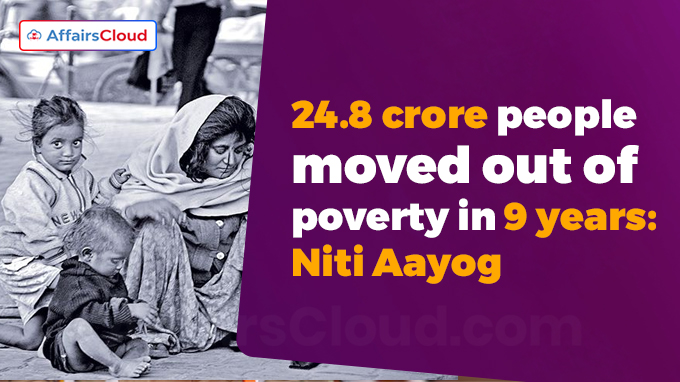 The National Institution for Transforming India’s (NITI Aayog) discussion paper on the National Multidimensional Poverty Index (MPI), ‘National Multidimensional Poverty: A Progress Review -2023,’ has reduced India’s Multidimensional poverty from 29.17% (2013-14) to 11.28% (2022-23), with about 24.82 crore individuals emerged from poverty during this transformative period.
The National Institution for Transforming India’s (NITI Aayog) discussion paper on the National Multidimensional Poverty Index (MPI), ‘National Multidimensional Poverty: A Progress Review -2023,’ has reduced India’s Multidimensional poverty from 29.17% (2013-14) to 11.28% (2022-23), with about 24.82 crore individuals emerged from poverty during this transformative period.
- At the State level, Uttar Pradesh leads the list with 5.94 crore people escaping poverty, followed by Bihar at 3.77 crore and Madhya Pradesh at 2.30 crore.
Point to note:
i.The report on the National MPI was based on the data from the National Family Health Surveys (NFHS) 4 (2015-16) and 5 (2019-21), showing that 13.5 crore people escaped poverty between 2015-16 and 2019-21.
- Multidimensional poverty for India for the years 2005-06, 2015-16, and 2019-21, was estimated using data from the corresponding NFHS rounds 3 to 5.
ii.With this rate of decline in India’s Multidimensional Poverty, India is expected to reach a single-digit level of poverty by the year 2024-25.
iii.The progress in MPI demonstrates India’s dedication to achieving the United Nations (UN) Sustainable Development Goals (SDGs) target of 1.2 (reducing multidimensional poverty by at least half) much ahead of 2030.
About the National Multidimensional Poverty Index (MPI):
i.The National MPI by NITI Aayog utilizes the internationally acclaimed Alkire and Foster (AF) methodology, diverging from the global MPI (covers 10 indicators) by encompassing 12 indicators.
- The indicators include Nutrition, Child and Adolescent Mortality; Maternal Health; Cooking Fuel; Sanitation; Drinking Water; Electricity, etc.
ii.The national MPI retains all the 10 indicators from the global MPI and incorporates 2 additional indicators namely Maternal Health and Bank Accounts, aligning with India’s national priorities.
iii.This analysis delves into the decline of poverty rates and the number of multidimensionally poor people in India over different periods.
iv.MPI is considered a profound measure, offering a direct and comprehensive measure of people’s deprivation and poverty.
- It captures and reveals the outcome of economic growth and development, income and distribution, and various development initiatives of the State.
Constructing India’s MPI:
i.As part of the Global Indices for Reform and Action (GIRG) initiative, NITI Aayog has taken on the task of constructing an indigenized index for measuring multidimensional poverty.
ii.The National MPI adopts the dual-cutoff approach of the AF methodology, aligning with the global MPI report.
Substantial Reductions in Poverty:
i.As per the report, between 2015-16 and 2019-21, 13.5 crore people escaped poverty.
ii.Rural areas witnessed a more significant decline in poverty compared to urban regions.
- Rural poverty dropped from 32.59% to 19.28%, while urban poverty decreased from 8.65% to 5.27%.
Improvements in Indicators:
Significant reductions (improvement) were observed in all 12 indicators over the two periods between 2015-16 and 2019-21.
Notable decreases: 21.8% points in sanitation, and 14.6% points in cooking fuel.
Regional Observations:
i.States showing the fastest reduction in multidimensional poverty: Uttar Pradesh, Bihar, Madhya Pradesh, Odisha, and Rajasthan.
ii.Bihar, with the highest MPI value in NFHS-4 (2015-16), experienced the largest decline in the headcount ratio.
iii.Uttar Pradesh led with 3.43 crore people escaping multidimensional poverty;
- Bihar and Madhya Pradesh followed with 2.25 crore and 1.36 crore individuals, respectively.
Estimates and Projections:
i.In 2013-14, the headcount ratio was 29.17%, while the projected ratio for 2022-23 stands at 11.28%.
ii.Absolute change over 9 years indicates a remarkable 17.89% point reduction, liberating approximately 24.82 crore individuals from multidimensional poverty.
Global Perspective:
World Bank’s international poverty line at USD 2.15 a day (2017 Purchasing Power Parity (PPP) terms) indicates a decline in the poverty headcount ratio in India from 18.73% (2015) to 11.9% (2021).
Recent related News:
The United Nations Development Programme (UNDP) released its “2024 Asia-Pacific Human Development Report: Making Our Future: New Directions for Human Development in Asia and the Pacific” stating India is among the top countries with high income and highest wealth inequality, despite rapid economic growth.
About National Institution for Transforming India (NITI Aayog):
Chairperson– Narendra Modi
Chief Executive Officer (CEO)- B.V.R. Subrahmanyam
Headquarters– New Delhi, Delhi
NITI Aayog was formed via a resolution of the Union Cabinet on 1 January 2015. It is a policy think tank for the Indian government. It came into effect on 16 February 2015 via a notification by the Cabinet Secretariat.




